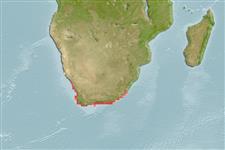Common names from other countries
Environment: milieu / climate zone / depth range / distribution range
Ecología
marino demersal. Subtropical; 27°S - 35°S
Southeast Atlantic: Lüderitzbucht, Namibia to East London, South Africa.
Tamaño / Peso / Age
Maturity: Lm ? range ? - ? cm
Max length : 30.0 cm TL macho / no sexado; (Ref. 5496)
Short description
Claves de identificación | Morfología | Morfometría
Espinas dorsales (total) : 46 - 50; Radios blandos dorsales (total) : 2 - 4; Espinas anales: 2; Radios blandos anales: 33 - 37. Red or brown in color; large black blotch below 1st 3 dorsal spines; black dots around eye and on body (Ref. 5496). Juveniles black with red margins to dorsal, anal and caudal fins; small juveniles purple-black with a white caudal fin (Ref. 5496).
Found in pools and subtidal areas.
Life cycle and mating behavior
Maturities | Reproducción | Spawnings | Egg(s) | Fecundities | Larva
Smith, M.M., 1986. Clinidae. p. 758-769. In M.M. Smith and P.C. Heemstra (eds.) Smiths' sea fishes. Springer-Verlag, Berlin. (Ref. 5496)
IUCN Red List Status (Ref. 130435)
CITES (Ref. 128078)
Not Evaluated
Threat to humans
Harmless
Human uses
Herramientas
Special reports
Download XML
Fuentes de Internet
Estimates based on models
Preferred temperature (Ref.
115969): 16.1 - 22.2, mean 18.6 (based on 57 cells).
Phylogenetic diversity index (Ref.
82804): PD
50 = 0.7500 [Uniqueness, from 0.5 = low to 2.0 = high].
Bayesian length-weight: a=0.00513 (0.00223 - 0.01182), b=3.06 (2.86 - 3.26), in cm Total Length, based on LWR estimates for this (Sub)family-body shape (Ref.
93245).
Nivel trófico (Ref.
69278): 3.5 ±0.4 se; based on size and trophs of closest relatives
Resiliencia (Ref.
120179): Medio, población duplicada en un tiempo mínimo de 1.4-4.4 años (Preliminary K or Fecundity.).
Fishing Vulnerability (Ref.
59153): Low vulnerability (20 of 100).
